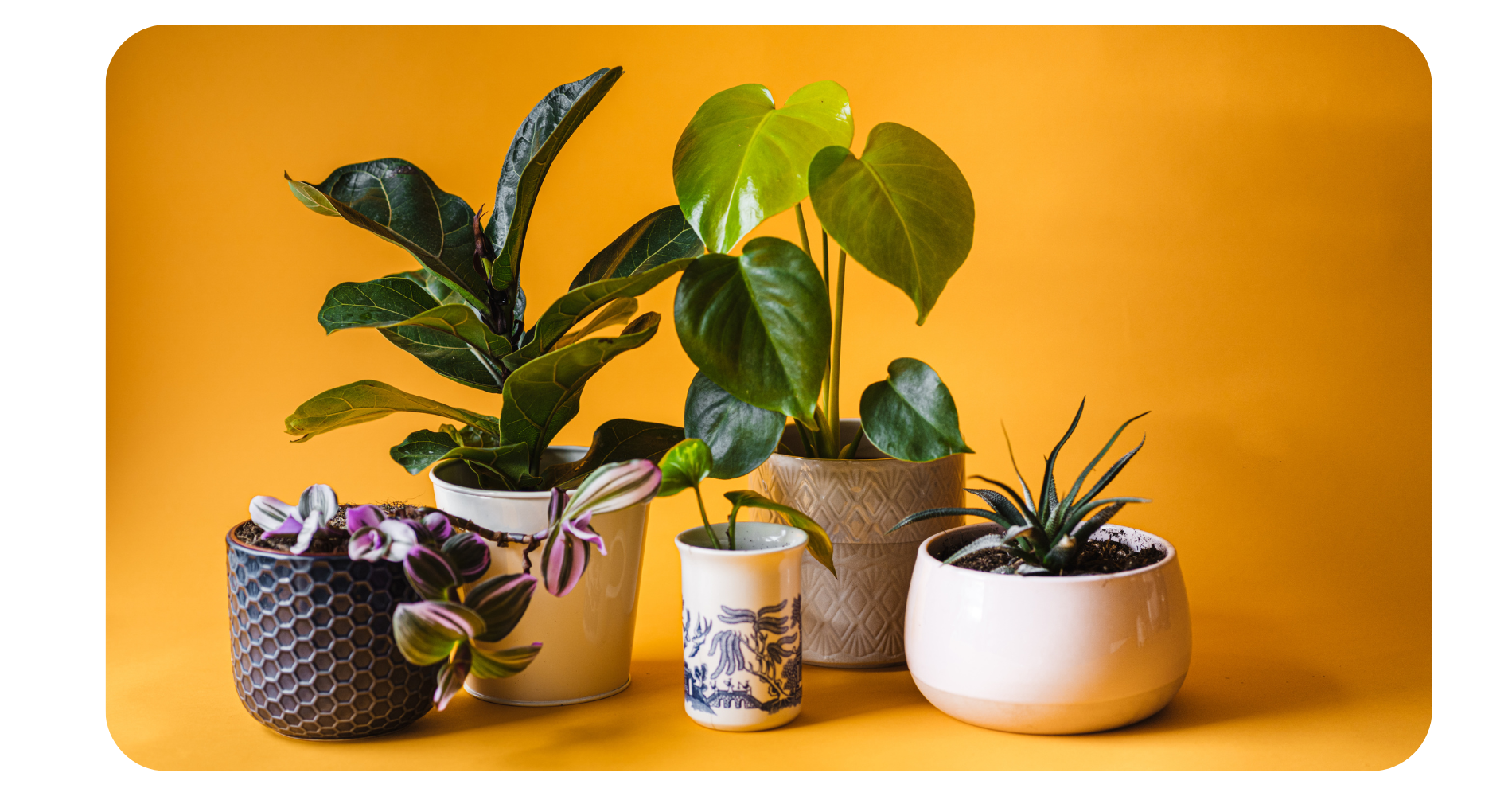How to choose the perfect pot for your plants
Anything can be a plant pot if you are brave enough: an old car tyre, a chopped up plastic bottle, or even your shoes. Choosing the perfect pot for your beloved plant may seem like a challenge, but fear not - it's a crucial step in keeping your plant healthy and thriving. In this blog we'll be exploring all the factors that go into selecting the perfect pot, from size to material, drainage to aesthetics, so you can choose the perfect pot for your plant!

Size
Choosing the right pot size is crucial for healthy plant growth. A pot that's too small can limit growth, while a pot that's too large can lead to overwatering and root rot. As a general rule, you should choose a pot that is 10- 20% larger than the current pot your plant is in. This provides enough room for growth without overwhelming the plant. However, keep in mind that different plants have different growth habits, so you may need to adjust pot size accordingly.
For instance, tall and skinny plants like snake plants may not need as much space as wide and bushy plants like peace lilies. Selecting the right pot size is a crucial step in ensuring the health and vitality of your beloved plants. If you leave your plant in a pot that’s too small for too long, the roots can become bound, requiring you to break them to repot the plant. This is something you want to avoid, so it's important to do it sooner rather than later. Don't let your plants outgrow their pots or suffocate in pots that are too big.
Material
The material of your pot is another important factor to consider. There are several materials to choose from, each with its own benefits and drawbacks:
- Clay pots are a popular choice due to their porous nature, allowing for great airflow to the roots. They are also heavy, making them ideal for larger plants that may tip over in lighter pots. However, clay pots can be prone to cracking and may not be suitable for moisture-loving plants, as they tend to dry out quickly.
- Plastic pots, on the other hand, are lightweight, affordable, and come in a wide range of sizes and colors. They are easy to find and convenient to use. However, they may not provide adequate airflow to the roots, potentially leading to overwatering and root rot.
- Ceramic pots are a beautiful and durable choice for indoor plants. With a variety of colors and styles available, they add aesthetic appeal to your space. However, like clay pots, they may not be ideal for moisture-loving plants.
Consider the unique needs of your plant and weigh the pros and cons of different pot materials. Whether it's porous clay, lightweight plastic, or stylish ceramic, choose the right material for your plant's health and beauty!
Drainage
Proper drainage is vital for your plant's well-being. Without it, overwatering and root rot can occur. When selecting a pot, prioritize those with drainage holes in the bottom. If you come across a pot you love that lacks drainage holes, don't worry - you can easily drill them yourself. In addition to drainage holes, it's essential to choose a pot with a saucer or tray to catch excess water (especially for indoor plants). This prevents water from pooling on your floors or furniture and helps prevent overwatering, ensuring your plant stays healthy and thriving.
This is where a useful technique called ‘bottom watering’ can be used. It is when you fill the saucer or tray at the bottom of the pot instead of watering the soil from the top. Why water the plant this way you might ask? Have you ever watered your plant to the point where the drainage plate overflows and you’re frantically trying to find a towel before it runs everywhere? Well, the bottom watering method allows the plant to take up water as needed, promoting healthy root growth. It also provides an opportunity to observe how much water the plant consumes.
Shape
When selecting a pot for your plants, the shape of the pot plays an important role in their overall well-being. It directly impacts the available space for the plant's root system, which is vital for healthy growth. When deciding on the pot shape, it's therefore essential to consider the growth habits of the plant.
For example, plants with deep root systems, such as carrots or some trees, may benefit from taller pots. On the other hand, plants with more shallow root systems, like herbs or succulents, may thrive in wider, shallow pots. Matching the pot shape to the plant's root structure allows for optimal root growth and development. Furthermore, it's important to think about the pot's stability. Look for a pot with a wider base or ensure it is heavy enough to prevent any toppling over as the plant grows larger or during windy conditions.

Multiple plants in one pot
Plants do enjoy social gatherings but they do like their own space. Generally it is advisable to give each plant its own solo pot. Let them shine independently and hog the spotlight! But if you can't resist mixing and matching, make sure your chosen plant companions have similar water and nutrient requirements. Additionally, there are other things to take into consideration so we would advise you to always do your research before you decide to mix different plants in one pot.
Something to consider is when multiple plants share a pot, they become competitors for vital resources like water, nutrients, and light. Plants will also have different needs in terms of nutrients and water. Some plants may be thirsty while others are more reserved in their water intake. Striking the right balance can be challenging, ensuring everyone gets just the right amount of H2O to quench their thirst. Additionally, when plants are crammed together, their roots can't stretch out and find their own space to thrive. This leads to a condition known as being 'root-bound,' and it's a recipe for growth setbacks, nutrient imbalances, and even an invitation for unwanted guests like pests and diseases.
In general, it is best to avoid adding multiple plants to one pot. Instead, choose a pot that is appropriately sized for each individual plant and provide them with their own growing space. If you do decide to group plants together, make sure they have similar water and nutrient requirements and that they are all healthy and disease-free.
Aesthetics
Finally, consider the looks of your pot. Your pot is after all not only functional but also a statement piece in your home, garden or office. Consider the style, color, and texture of your pot to enhance your plant's overall look. A well-chosen pot can elevate the aesthetics of your space and create a visually appealing display. Make your plant and pot a dynamic duo, matching the color or texture of your plant with your pot for a stylish look. Let your creativity shine. With the right pot, you can set your plant up for success!
Embrace the excitement of finding the perfect pot that combines functionality and aesthetics, and watch your beloved plant thrive in style. Happy pot hunting!


 Deutsch
Deutsch  Français
Français  Español
Español 
.png?ts=1686750215)